-
Posts
49 -
Joined
-
Last visited
-
Days Won
1
Content Type
Profiles
Forums
Blogs
Gallery
Posts posted by Wapata
-
-
Topic ready to be closed.
I have taken 3 pcb to 5€ each so... it's good for me. If I don't use the 3, i'll sell the two unused (for guess.. 5€ + postage in europe) !
I'll tell you if and when it will be available !

-
Hi everyone !
Do anyone have a MBHP_AINSER8 PCB to sell ? With an invoice to France and a payment with Paypal ? I only need one of it so...
http://www.ucapps.de/mbhp_ainser8.html
Thanks !
-
Thanks !
I have some time as I have to build AINSER8 Module (foot controller without AINSER8 doesn't work for me).
Regards, Wapata
-
-
On 27/01/2013 at 1:46 PM, TK. said:
The keyboard driver is now integrated into MIDIbox NG V1.014:
On 13/10/2014 at 11:59 PM, TK. said:Hi!
Using a MIDIbox Hardware Platform, CORE_STM32F4 Module do change the latency that prevent using MidiboxNG instead of MidiboxKb ?
I'm currently doing the keyboard but... There is no "octave up/down" buttons to wire on the MidiKB project. So I need a second STM32F4 with MidiboxNG to do that (and other things).
Will this slow down the latency ?
What is the best way to link the two STM32F4 (to have only one USB cable to the computer) ? Usb via USB host ? Midi ? An other way ?
Other question: how do YOU use the midi router of MidiboxKb ? I think it's cool to make old midi stuff converted to USB but I may miss something.
Please tell me if I not clear !
-
it's here: http://www.ucapps.de/mios32_download.html
Only micro usb cable is needed to flash, and you will see two midi in and midi out instead of MIDIBox SEQ v4.
-
Woops. I've got questions: why did my 10p ribbon cable are not all the same ? If I make exactly like the pictures of DIO_MATRIX and MIDI I/O, the red line doesn't go to the same pin at all. It's reversed for the matrix one and pin to pin for the dio one. Is there a trick ? Or did I miss something big ?
Thanks for the help !
EDIT: oh... and don't do like me, it's not because 8 connectors are oriented the same way than the two lasts ones are too. J10B and J11E... And as it's hard to de-solder a 10 pins connector, you should think to turn the plastic part only.
-
Connect a pair of in/out to a midi to USB cable and use a virtual expender, or a pair of midi cable to the in/out of a keyboard with built in sound card, or midi in to a master keyboard and midi out to an expender. Or just a master keyboard and the LEDs of the midi ports.
Or with an oscilloscope ?
-
Here we go !
18h20, the iron is warming. 20h00, it's cooling down.
Thanks to Modular Addict and TK (and this page: http://www.ucapps.de/mbhp_core_stm32f4.html ) I have to say it: it's SUPER easy to make !
Next, i will make the DIO_MATRIX and MIDI_IO boards.
TK. ... You make a really good job, you're cool enough to share it with us... So thanks again !
-
Yes it's true, we have to find a system. It's the stepfather work to find it. I have the solder and computer side, he as the rests.
Thanks for the help !
-
Thanks for the answer. I have bought all but the switches now.
I have to make prototypes with what I have to see what can or can't work. The double IR switches are on the list. As well as classic micro-contact and round 7mm. Looking for quiet action. But even at 1 euro per switch, I'm far away from a 1200 euros keyboard.
The ir switches may be good but will need power.. but it sound the best solution for me IF we find a place to put them easily.
... Do 1n4002 diode behind the switches would work ? I know the it's more for power than logic.. but I have something like 1000 pcs at home and no other.
By the way, I just see that I didn't mention a thing: the piano wires who doesn't sound good will be definitely cut ! The piano will be midi only.
-
On 13/10/2014 at 11:59 PM, TK. said:
o added "break_is_make" option which allows to trigger a note when the break
contact is activated (nice for playing organ style)
Hi!
Can you explain why did this option exist ?
I mean... How can it feel different than idle contact + break contact + velocity 255 ?
Or maybe it is 'just' the "no velocity keyboard" implementation ?
Thanks
-
Thank you so much for this link ! I was note able to find a shop with theses products ! I've been thinking that it was normal due to the open-source way (i hope it's an understable sentence)... so thanks.
So. Let's go for MBHP_CORE_STM32F4, two MBHP_DIO_MATRIX ! I've midi ports in stock maybe USB B female port too, pots for the pedals, and i'm searching the 88x2 buttons right now (with no 'clic' sound) to put them in the way of the piano's hammer. The raspberry expander is working great (and i have to find western piano sounds for the father in law), a chines 20Wrms amps is there... Just need some good old speakers now.
Let's find the rest of the onboards electronic parts now ! Oh... and restock some meters of electric cable too.
Please keep helping so great, it's very cool

-
Nice !
That was the part that i did not understand. Because I'm not a MIOS user yet I suppose.
For a project like this one, do you think the MBHP_CORE_LPC17 PCB is needed, or the LPCXPRESSO nude (like ''Minimal Circuit to get USB running'') is enought ? The hardware plateforme is not as easy to get than the Lpcxpresso (or did i miss a link for a kit somewhere ?).
Thanks for the answer !
-
Hi everyone !
My father in law wish to make his hold piano (who sound like a sick dog) a midi one... to make it playable by my futur kid.
At first i've re-take a look at this: http://www.ucapps.de/index.html?page=midibox_kb.html but it's up to 64 keys.
So, just to be sure, for me, it seem that i need a CORE_STM32F4 Module (nude should be okay), a DIO_MATRIX Module (for now i dont see how many...), 2 momentary button per key and this http://www.samplerbox.org/. (no screen, minimum buttons).
I'll be able to use the 88 keys with velocity, 2 pedals, 2 program buttons, midi in, midi out, with midi port and usb. And may be a relay for switching on and off the sound amplifier).
I am good with this, or there is simpler for this particular project ?
Thanks for reading, maybe answering and... for being here !
ps: I know ucapps and midibox for years... i'm happy to finally use this work !
-
Ben y a pas d'autre touch lol
(Et je suis pas chez moi à côté de ma Doc :-/ )
Pour la vélocité, c'est finalement le message "note 36, force 140" qui est envoyé. Donc pas de cc en effet.
Du coup, l'After touch dans son principe demeure un mystère pour moi.
Car cela ne peut plus être réalisé avec deux inter par touche comme sur un clavier standard je suppose, il faut les remplacer par une plaque sensible à la pression (dont j'ai oublié le nom mais que je pourrais retrouver ce soir) non ?
(Au fait, merci pour tes réponses)
-
Pour l'exemple, un Yamaha DSR2000. Mais les deux molettes que tous les claviers maîtres ont doivent porter le même message non ?
Merci pour le lien, j'avais vu sur le site, mais pas réussi à le retrouver sur le forum !
-
Je parle d'un clavier maître.
Je réfléchi à me faire un clavier avec l'intégralité des octaves et notes, et je réfléchis à si oui ou non j'ai besoin de deux contacts par touche, ou si je pourrais gérer ça par potar (sur un autre élément, pour avoir un clavier nu intégré dans le bureau)
Mais je me rends compte que je ne connais pas les numéros CC de vélocité etafter touch. Et si c'est pas des CC, c'est quoi ?
Ahhh ! C'est un message de note !?
-
Salut à tous !
J'ai un petit soucis de compréhension au niveau des paramètres vélocité, after touch, CC11 Expression et enfin CC7 Volume.
A un volume CC7 donné, le CC11 permet d'obtenir un pourcentage de CC7, sans toucher au volume CC7 globale du canal.
La question est la suivant: du coup, la vélocité et l'after touch, c'est sur CC7 qu'ils jouent ?Merci et à bientôt !


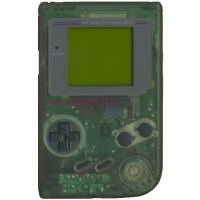
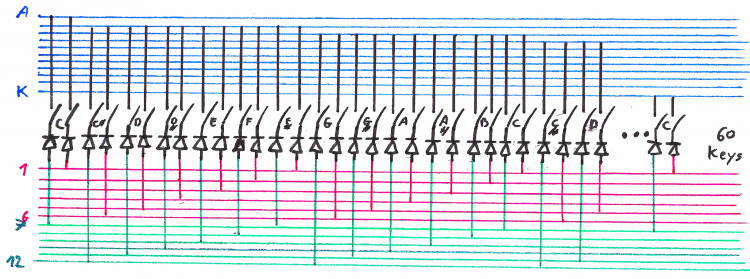
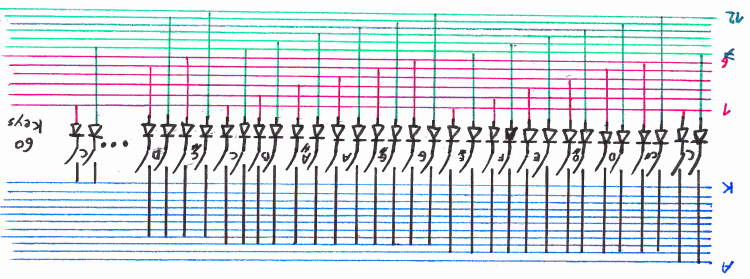
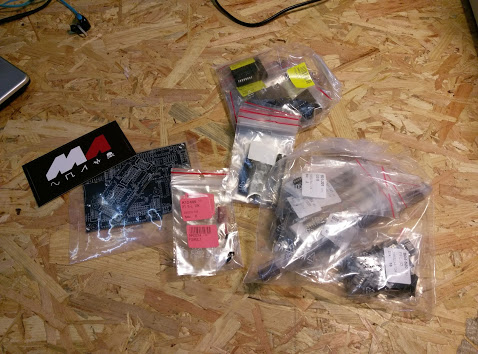
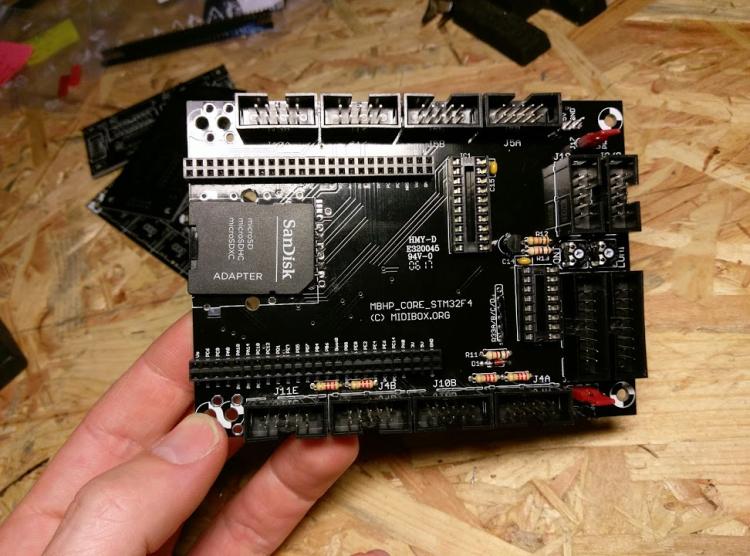
CORE_STM32F4 Module, LCD, and fire
in MIDIbox Documentation Project
Posted
Hi !
It may be because English is not my native language but I have to say : The LCD part of the CORE_STM32F4 Module page is not clear at all. Because of that (and because I didn't take the time to check the VCC and Ground BEFORE soldering) my LCD have made this typical sound of... fire starting.
I have followed this page: http://www.ucapps.de/index.html?page=mbhp_lcd.html / MIOS32 Connectivity / Wiring Diagram for 2x16: mbhp_lcd_mios32.pdf (as my LCD have all the pins in line).
But after that... the wire 3 is NOT V0. So the sentence "Order of wires is matching with flat ribbon cable" doesn't work. And I can't figure out how it can work (with the J15 port at his place). For me all the wire have to be twisted two by two. It's too cold is the garage right now, i will try tomorrow.